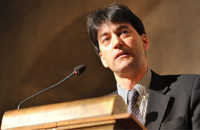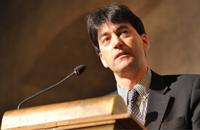Conference: the Impact of Computing at CERN on Society, by Dr. Bob Jones, CERN IT department - 22.05.2014 Globe
Science and society : the impact of computing at CERN on society, by Dr. Bob Jones, CERN IT department
Thursday 22 May 2014 at 7:30 p.m.
Globe of Science and Innovation
Route de Meyrin, 1211 Genève
Lecture in English, with simultaneous interpreting into French
Abstract
CERN is often referred to as the place “where the web was born”. The world-wide-web has fundamentally changed society and launched a wave of new global industries. The world-wide-web happened because there was a specific problem that was seen as an Information Technology (IT) challenge by its inventors. As the scientific programme of CERN has progressed, new IT challenges have been faced such as how to handle the mind-boggling amount of data that is produced by the Large Hadron Collider (LHC). Being able to face those challenges has contributed to the success of the LHC and the discovery of the Higgs particle. This public lecture will explore some of those challenges, how they have been tackled and what impact they are having beyond physics and ultimately on society as a whole.
 Biography
Biography
Bob Jones is head of the CERN openlab project (openlab.cern.ch) which is a unique public-private partnership between CERN and leading ICT companies. Its mission is to accelerate the development of cutting-edge solutions to be used by the worldwide LHC community.
Bob is a member of the management team of the Helix Nebula – the Science Cloud initiative (http://www.helix-nebula.eu/), a public private partnership to explore the use of commercial cloud services for science applications.
Bob joined CERN in 1986 as a software developer providing support for the physics experiments running on the now dismantled Large Electron Positron (LEP) particle accelerator. He has been involved in several research projects for the LHC accelerator and has held the position of leader of the online software system for the ATLAS experiment (http://www.atlas.ch/) at the LHC.
His experience in the distributed computing arena includes mandates as the technical director and then project director of the EGEE projects (2004-2010 http://www.eu-egee.org), which established and operated a production grid facility for e-Science spanning 300 sites across 48 countries for more than 12,000 researchers.
This lecture is organised within the framework of CERN60 events
» No specialist knowledge required
» Entrance free
» Limited number of seats - registration is essential
» Reservation: +41 22 767 76 76 or cern.reception@cern.ch
"Science et société : l'impact de l'informatique développée au CERN sur la société", par Bob Jones, département IT du CERN
19h30, au Globe de la science et de l'innovation
La conférence sera donnée en anglais et traduite en français.
Réservation indispensable : +41 22 767 76 76 or cern.reception@cern.ch
Plus d’informations sur : http://outreach.web.cern.ch/outreach/FR/evenements/conferences.html
Retrouvez également tous les événements organisés par le CERN en 2014 sur www.cern.ch/cern60
Résumé
On parle souvent du CERN comme le « berceau du web ». Le web a changé notre société en profondeur et a contribué à la création de nouvelles industries globales. Le web a vu le jour parce que ses créateurs avaient un problème précis à résoudre qu’ils ont considéré comme un défi de la technologie de l’information. Le programme scientifique du CERN s'est depuis développé, créant de nouveaux défis tels que la gestion de la montagne de données produites par le Grand collisionneur de hadrons (LHC). La capacité de faire face à ces questions a contribué au succès du LHC et à la découverte de la particule de Higgs. Cette conférence publique abordera certaines de ces questions, la façon dont elles ont été résolues et l’impact qu’elles ont au-delà de la physique, et en fin de compte, sur la société entière.
 Curriculum Vitae
Curriculum Vitae
Bob Jones est responsable du projet CERN openlab(openlab.cern.ch), un partenariat unique en son genre entre le CERN et des entreprises privées spécialisées dans les technologies de l'information et de la communication. L’objectif de ce projet est de stimuler le développement de solutions de pointe utiles à la communauté LHC du monde entier.
Bob est aussi membre de la direction du projet Helix Nebula – the Science Cloud (http://www.helix-nebula.eu/), un partenariat public-privé qui explore l’usage de services commerciaux en nuage pour des applications scientifiques.
Bob a rejoint le CERN en 1986 en tant que développeur de logiciels, pour apporter son appui aux expériences de physique menées auprès du Grand accélérateur électron-positon (LEP), aujourd’hui démantelé. Il a également participé à de nombreux projets de recherche pour l’accélérateur LHC et a été responsable du système de logiciels en ligne pour l’expérience ATLAS (http://www.atlas.ch/) du LHC.
Son expérience en infrastructures de calcul distribuées comprend des mandats en tant que directeur technique d’abord, puis en tant que directeur, des projets EGEE (Enabling Grids for E-sciencE) qui ont créé et exploité une infrastructure de grille de production couvrant 300 sites dans 48 pays différents, et utilisée par plus 12 000 chercheurs.

